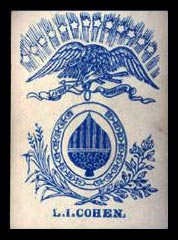
|
| « History of Playing Cards | Early Standards | Gallery of Playing Cards | Card Games Rules | CONTACT |
Lewis I. Cohen
Playing Cards, History, America 19th Century
Lewis I. Cohen, a stationer by trade, was born in Lancaster, Pennsylvania in 1800. He went to England in 1814, and he was apprenticed to his half brother, Solomon Cohen, a well-known lead pencil manufacturer in London. In 1819, he returned to the United States on the barque Mary and Susan.
As they were docking at the Burling Slip, he chanced upon a Florida schooner at the other side of the wharf, which was loaded with cedar logs. He was delighted to find such great lengths of timber and without any knots.
He promptly bought the entire shipment for 30 pounds, musing that he was paying only a fraction per log of what his brother, Solomon, was paying per foot in London.
If that were not to be indicative of the shrewdness and facility of the young man, he also managed to talk Captain Champlin of the Mary & Susan, into carting the load back with him as ballast, meaning without cost.
The days events had laid the foundation of the Cohen fortune. Lewis I. Cohen was to make a name for himself as the first American to make lead pencils. He would also become the first stationer in America to sell steel pens in place of old quills.
Cohen's greatest achievement and contribution to playing card manufacture would come in the form of mechanized colour printing. He was a pioneer in the field, and like many of his contemporaries (George Baxter 1836, Thomas de la Rue, 1831) came up with a very similar solution for the problem of printing four colours in one pass. In 1835 he registered a colour-printing machine that could, in one impression, press four colours.

Lewis I. Cohen published his first deck of playing cards in 1832 and formed his business, L. I. Cohen, New York. His insignia (the Ace of Spades) was to be an Eagle perched atop the suit symbol, enshrined by thirteen shining stars. Though, sometimes, the stars were omitted.
From 1838 to 1844 he spent considerable sums of money enlarging his premises and expanding his enterprise, and in 1845 he issued a deck of gold embossed playing cards. That was all the Kings and Queens, and all the numbers, Cohen embossed with gold around the suit symbols and on the royal attire. Nothing says it quite like gold. In 1850, he sold the stationery side of the business, which was now dwarfed by the card manufactory and it wasn't long before the young Mister Cohen could put his feet up and let his sons take the reigns.
In 1854 Lewis I. Cohen retired from business and left the card manufactory in the hands of his son, Solomon L. Cohen, and his nephew, John M. Lawrence who formed a partnership and traded under the name "Lawrence and Cohen".
The two boys continued their brand with the Stars and Eagle, and maintained their share of the market and expanded. On December 5th, 1871, Lawrence and Cohen turned the business into a stock company together with three new partners. The new names in the venture were Samuel Hart and Isaac Levy of “Samuel Hart & Co.”, Philadelphia, and John J. Levy, a card maker from New York. Together, these men would form the New York Consolidated Card Company.
L I N K S
Gallery of Early Standard Playing Cards
WikiPedia - Lewis I. Cohen
Lewis I. Cohen 1840 - PlainBacks.com
Lewis I. Cohen - Gold Embossed 1845
Card Masters of the |
||||||||
| Thomas de la Rue | ||||||||
| Lewis I. Cohen | ||||||||
| Lawrence & Cohen | ||||||||
| Samuel Hart | ||||||||
| Andrew Dougherty | ||||||||
| Ferdinand Piatnik | ||||||||
| ||||||||
|
||||||||
| ||||||||
|